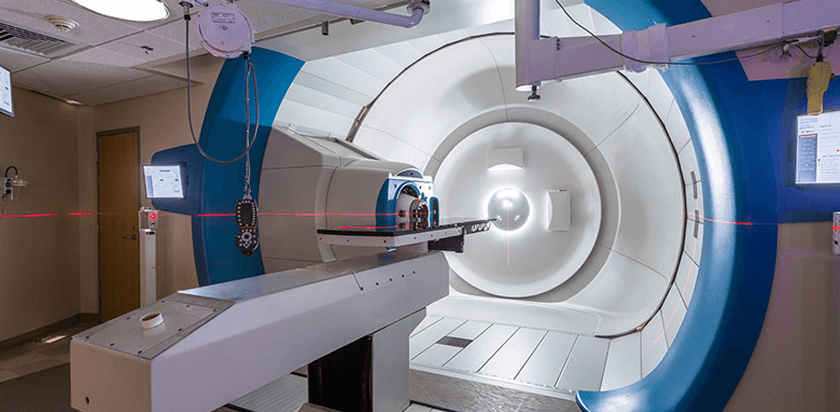
Latest Research Publications from the UF Health Proton Therapy Institute
Each research study published is one step forward to better understanding cancer and the effectiveness of cancer treatment options. Below are the latest publications by our physicians, either as primary investigators or co-authors with oncology experts from around the world.
The UF Health Proton Therapy Institute physicians, physicists and contributing staff members are indicated in bold.
Read our full research portfolio here.
Breast Cancer
Article Title:
Postmastectomy Radiation Therapy: An ASTRO/ASCO/SSO Clinical Practice Guideline September 2025
Authors:
Rachel B. Jimenez MD, Yara Abdou MD, Penny Anderson MD, Parul Barry MD, Lisa Bradfield BA, Julie A. Bradley MD, Lourdes D. Heras MPH, Atif Khan MD, MS, Cindy Matsen MD, Rachel Rabinovitch MD, Chantal Reyna MD, MHA, Kilian E. Salerno MD, Sarah E. Schellhorn MD, Deborah Schofield PhD, Kekoa Taparra MD, PhD, MPH, Iman Washington MD, Jean L. Wright MD, Youssef H. Zeidan MD, PhD, Richard C. Zellars MD & Kathleen C. Horst MD
Why this is important:
Dr. Bradley served on this ASTRO task force along with other renowned breast cancer experts across the country, yielding this consensus statement focused on radiotherapy after mastectomy. This publication details the indications for post-mastectomy radiotherapy, along with specifics for delivering high quality care including radiotherapy dose and fractionation and technique. This guideline will play an important role in supporting quality radiotherapy at all centers nationally.
Article Title:
Radiation-Induced Acute Lung Pneumonitis After Pencil-Beam Scanning Proton Treatment for Breast Cancer: Correlation With Dose-Volume Parameters and Optimization Objectives to Reduce Lung Toxicities August 2025
Authors:
Jiyeon Park, PhD, Julie Bradley, MD, MHCDS, Nancy P. Mendenhall, MD, FACR, FASTRO, Raymond Mailhot, MD, MPH, Teena Burchianti, MSN, APRN, ANP-BC, OCN, Yawei Zhang, PhD, Hardev Grewal, PhD, Mohammad Saki, DSc, PhD, Twyla Willoughby, PhD, FAAPM, Perry B. Johnson, PhD, Mark Artz, PhD, MBA
Why this is important:
This technical article on pencil beam scanning for the treatment of people with breast cancer assessed the relationship between the dose distribution and an uncommon side effect to the lung. The data from this analysis informed modifications to treatment planning to further minimize the risk of a pulmonary side effect from exposure of the lung to radiation.
Pediatric Cancer
Article Title:
Dental Adverse Effects Following Multimodality Treatment for Head and Neck Rhabdomyosarcoma: Results of a Trans-Atlantic Multicentre Study September 2025
Authors:
Koen B. Krommenhoek, Marinka L. F. Hol, Olga Slater, Mark N. Gaze, Willem M. M. Fennis, Frederic J. Kolb, Ludwig Smeele, Daniel J. Indelicato, MD, Reinier C. Hoogeveen, Alfred G. Becking, Johannes H. M. Merks
Why this is important:
There has not been much research done on the effects of cancer treatment on the teeth and gums of children treated for head and neck cancers. Luckily, treatments have improved and many children are thriving for years after treatment. However, this article highlighted that a majority of the patients, studied anywhere from 2 to 29 years after treatment, had missing teeth, tooth decay, gingivitis and significant plaque buildup. This study highlights the importance of regular oral hygiene and follow-ups for dental care.
Gynecological Cancers
Article Title:
A systematic study on local failure events post chemoradiotherapy for cervical cancer: understanding the impact of baseline lateral anatomical compartment involvement September 2025
Authors:
Lucas Gomes Sapienza, MD, PhD, Gustavo Guitmann, MD, Christopher G. Morris, MS, Paul G. Okunieff, MD, Michelle Suzanne Ludwig, MD, MPH, PhD, Maria José Leite Gomes, MD, MS, Isidore Daniel Benrubi, MD, MPH, Karina E. Hew, MD
Why this is important:
It is important to identify the areas of the body most susceptible to the cancer returning in the same location. This publication reviewed cases of cervical cancer where patients had both chemo and radiation, including brachytherapy. In this study, the researchers successfully mapped the locations of the relapses that occurred most often and provided strategic information that can be utilized to tailor treatment and potentially reduce the chance of recurrence while minimizing side effects.
